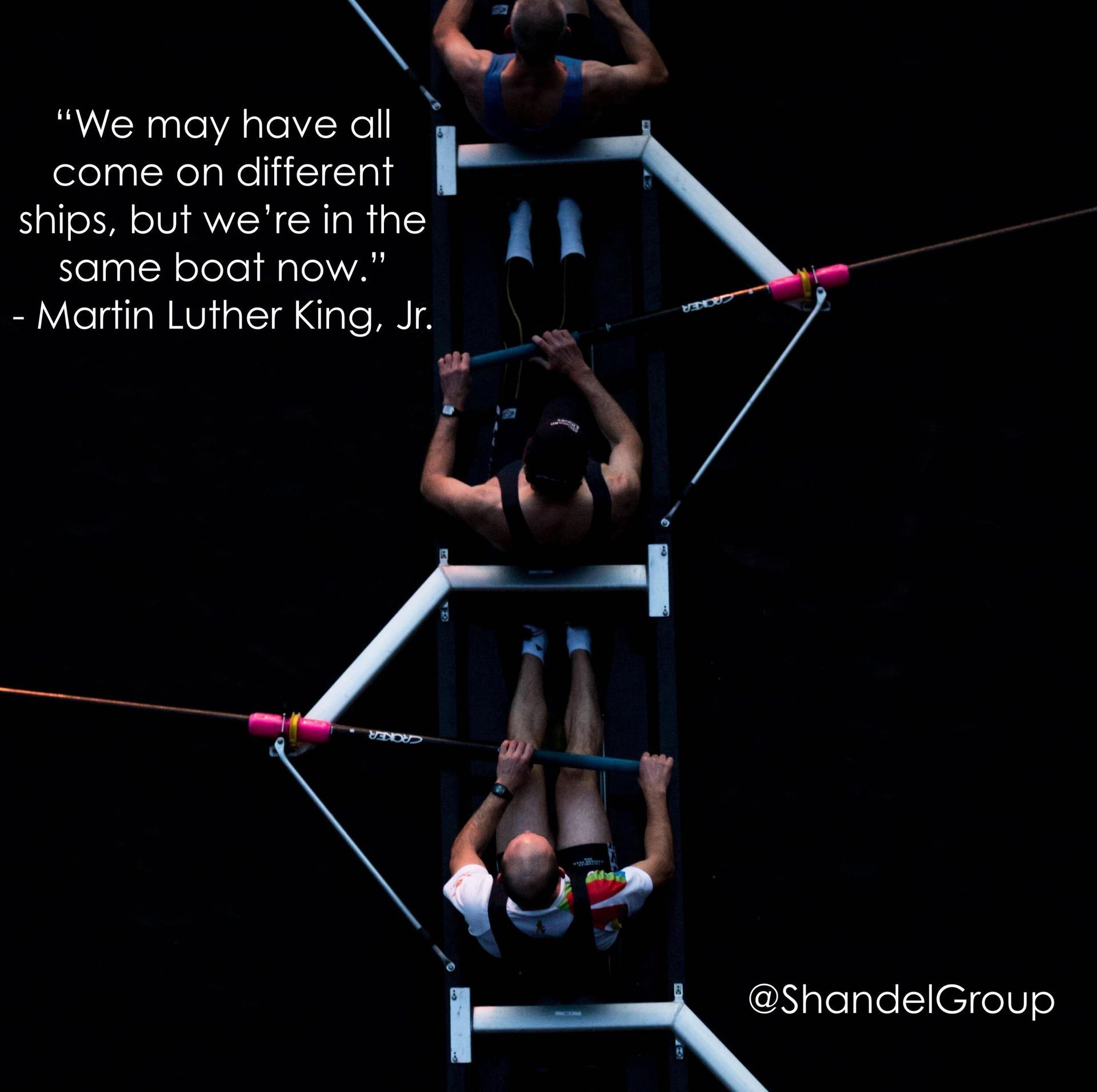CREATE A MORE PRODUCTIVE HOME OFFICE

5-Minute Read
At Shandel Group, we are thrilled to have partnered with Redfin to wrap up 2020. So many organizations and individuals have moved to remote work that Redfin wanted to create a comprehensive list of the tools and tactics for optimal productivity AND mental health.
Enjoy this enlightening read. And a big “Thank You” to Redfin for including us with this wonderful group of colleagues.
Pulling for you,
Alan Andersen
EXPERTS REVEAL HOW TO CREATE A MORE PRODUCTIVE HOME OFFICE SETUP THIS WINTER
As many of us continue to work from home this winter, you may be looking for creative ways to stay productive during the colder months. Before, we were able to take advantage of the warmer weather, go on a quick walk outside, and had plenty of sunlight pouring into our home office setup. But as the sun begins to set earlier and the cold temperatures are here to stay, staying motivated may become more of a challenge.
The good news is, there are plenty of ways to combat the winter gloom and boost your productivity as you work from home. To help, we reached out to top productivity experts for their best tips and tricks to make your home office setup a more productive work environment. So whether you’re living in snowy Detroit or rainy Seattle, these expert tips are guaranteed to help make your home office a place of inspiration and motivation.
CREATE A DESIGNATED WORKSPACE
Find an area of your home to transform into your home office. It’s easier to focus on work when you have a designated workspace with no distractions around you. Whether it’s a room-turned-office or simply a desk-and-chair set up, a dedicated workspace tells you (and others) that this area is solely for working and other activities will have to wait. – Productive and Free
Make the best use of your available space. Having a designated spot in your home where you “go to work” can result in less distraction and deeper focus. If you have an actual office in your home, that’s ideal, but since every home is different, you’ll have to make the best use of your available space. Places that can work nicely are a kitchen counter (sit in the same spot each time), the dining room table, or a hallway desk. – Wes Pinkston
Set up your workspace for productivity rather than leisure. You can set yourself up for a successful workday at home by working in a designated space with minimal distractions. Having a consistent workspace will help you mentally associate that space with productivity versus leisure. For that reason, it’s better to work from a space with an upright chair and table or desk rather than from your couch or bed. – Lyra Health
Don’t forget your home office essentials. Create a workspace that has everything you need to be productive. Purchase your favorite pens, notepads, and other work accessories that add a little pizazz to the work experience. Put up posters or pictures around you that bring you joy and put you in a good mind space to get to work. – Cityscape Counseling
Create a place where things go. Purchase organizational tools for papers, pens, and all the other items that live on your desk or in your home office setup. Then, at the beginning or end of each work session, make sure your items go back to their “home”. This daily habit of decluttering will help you feel mentally ready to tackle the tough tasks that may come your way. – Be Inspired Counseling & Consulting
SPRUCE UP YOUR DESIGN FOR A MORE ENJOYABLE HOME OFFICE SETUP
Design your dream office. Sitting in an ugly, cramped office is the easiest way to decrease motivation and increase procrastination. You deserve to have a beautiful home office and it’s important to spend time and energy making it a reflection of who you want to be so that it inspires and empowers. – Tierra Wilson & Co
Decorate with items that spark inspiration and positivity. Although that ‘Mondays Suck’ poster with the disheveled cat on it may be cute, it’s important to be mindful of the messages with which we surround ourselves each day. The things we see day in and day out have a way of embedding themselves into our subconscious. Why not keep things in front of us each day that inspires us to keep moving ahead in a positive way. – Say Life! Personal Coaching
Make your home office a place you enjoy spending time. Hang art on the wall, get a comfortable and supportive chair, and as the darker days set in, make sure you have additional lighting if necessary. Lastly, add some greenery to freshen up your space. My personal favorite is a snake plant – it’s low maintenance, looks great, and has air purifying qualities that help reduce anxiety. – Kristy Vail Studio
Ambiance matters. Add plants or hang pictures that you like, listen to music you enjoy, allow yourself breaks for coffee or tea, try to keep your work materials organized, use a blanket or even a space heater to keep you cozy during the chilly months. Ambiance matters, and creating a workspace that is pleasing to our senses can help make the days more enjoyable. – Thrive Therapy & Counseling
Create a self-soothing work environment. Jump ahead of the negative emotions that may come with work by creating your very own self-soothing work environment. Hit all your five senses by adding nice lighting for your sight, adding a massager to your office chair for touch, jam out to your favorite tunes to satisfy those sounds, freshen the air with those scents that make your smile, and always have a nice cup of coffee, tea, or maybe a lil’ somethin’ somethin’ for the end of your workday. – Brittney Tatum, Lifeologie Counseling Therapist
ELIMINATE UNNECESSARY DISTRACTIONS
Distraction is the mortal enemy of productivity. Remove as many distractions from your home office setup as you can in order to make the most of that time. Deactivate Google Sync and run your browser in incognito mode so that you are less tempted to distract yourself with social media and other sites that require login credentials. – Blunt Therapy
Ditch the video calls. Go old school and do your meetings on a regular, old-fashioned phone call. No video means you can get up, move around, and even get outside. Remember, motion creates emotion and sitting around slumped over your desk in your house creates some pretty weak emotions. – Andrew Warner Life Coaching
Turning off most phone notifications or using do not disturb mode can go a long way toward your productivity. The Zeirgarnik effect is the tendency to remember an uncompleted task rather than a completed one. On average, it takes people 20 minutes to get back to what they were working on when a distraction occurs – so a few distractions can lead to hours of lost work. Stay conscious of when you get distracted by an incoming notification or some other task on your to-do list and then work to reduce those distractions from occurring again. – Finta
Use active desk setups appropriately so they don’t become a distraction. Perhaps you’ve already invested in a treadmill desk, bike desk, or other fitness-based workstation. These devices can do wonders for our productivity, but they can also have the opposite effect. If you’re spending too much energy on walking or pedaling, it can distract you from the brainpower you need to do your best work. Instead, use a lower setting so you’re still moving, but you can stay safely focused on your work. – The Non-Clinical PT
LIGHTING IS CRUCIAL WHEN CREATING A PRODUCTIVE HOME OFFICE SETUP
Create comfortable lighting in your home office setup. Some people choose to have white holiday lights on in their office throughout the fall and winter because they find that type of lighting soothing or energizing, while others turn on more lamps and other lights to achieve more and improve their moods. If you are looking to manage the winter slog of working from home, investing in good lighting can really brighten a work day and your mood! – Progress Wellness
Set up your desk to face a window. Have you ever put a plant near a window and notice it leaning that way after a few days? Well, humans can be like plants in this way – we need light to feel good. So, be like a plant and try facing your workspace towards a window so you see natural light and sunshine during those 9-5 work hours. – IntraSpectrum Counseling
Great lighting can improve your attitude and productivity. As winter sets in, the days get shorter, which means more time at your desk when it’s dark outside. Having pleasant lighting, sufficient lighting, and lighting the right place in your home office setup helps keep you motivated, energized, and productive. – MWTherapy
Consider investing in a UV-free lightbox or lamp that mimics natural light. “Light therapy” is used to treat seasonal affective disorder and can help regulate brain chemicals associated with sleep and mood. Sprucing up your space even a little bit with a higher intensity light can help you feel brighter and more energized during the shorter and darker winter days. – Therapy Group of NYC
WORK-LIFE BALANCE ISN’T JUST IMPORTANT, IT’S ESSENTIAL
Intentionally create space between your work and home life. When you can’t physically separate the workplace from your home, you have to be intentional about separating the two in order to effectively manage work stress, give your brain a rest, and fully give yourself permission to unwind. Set intentional work hours and create separation by going for a walk or implementing a routine that officially signifies the beginning and end of your workday. – Sarah Whitney – The Productive Musician
Have firm boundaries with your work hours. Just as creating a dedicated workspace is important, so is maintaining consistent work hours. End your workday at your scheduled time off and resume the following workday when you are feeling refreshed. Self-care includes having firm boundaries between your work and home life. – Find A Multicultural Therapist
Allow yourself to embrace the flexibility that comes with working from home. Whether you are enjoying having a more open schedule while working from home, struggling to commit to regular work hours, or finding freedom in a more personalized workday schedule, embrace the aspects of working from home that work for you. – Therapists of New York
Create a few small rituals to begin and end each day. Creating a productive home work environment is oftentimes more about what you do than what you have. For example, when I sit down with my laptop to work, I bring a pitcher of water with me and I light a candle. These two things are my signal that it’s time to get focused. At the end of the day, I block off the last 30 minutes to get myself organized. I clean out my inbox, think about tomorrow’s priorities, and tidy up. – Mother Nurture
Resist the urge to log back on. Avoid burnout by creating a clear end-of-day work shutdown ritual and then resist the temptation to log in later. Make a repeatable checklist including all the steps you’ll complete at the end of each day to set tomorrow up for success. Intentionally choose the feeling you want to have as you transition from work into your personal life. Calm? Present? And, finally, decide in advance how you’ll resist the urge to go back to work later in the evening. – Melisa Liberman
CREATE GOOD HABITS TO IMPROVE YOUR PRODUCTIVITY AND STAY MOTIVATED
Define what productivity means to you. Pause for a moment and consider what “productivity” actually is. Ultimately, productivity is a byproduct of clarity and competence. In order to get clear, order your entire day through these three phases: organize, prioritize, and execute. – Shandel Group
Try out functional imagery to get your day started. While sipping your morning coffee/tea, close your eyes and picture your day as you want it to play out and proactively plan for potential obstacles. We call this functional imagery and it works. – Grover Watson Coaching, LLC
Reimagine support at home. As leaders accustomed to working in a traditional office, we may have overlooked all of the built-in support that helps us stay productive at the office. To stay productive and happy from home, get creative with support for your home office. Spend time to connect with friends, go for walks, upgrade your coffee setup, and refresh your home office set up so it’s inspiring and warm. – Rodney Mueller
Develop “threshold rituals” that help you mentally transition from work time to family time and back again. Giving your brain a clear signal that you’re switching roles – like lighting a candle when you start a work block and blowing it out when you wrap up – can help you be all in for the moments that matter. – Brilliant Balance
Don’t forget to let yourself rest. Sleep between 6-8 hours every night. Sleep is not only a resting phase – while we sleep, we detoxify, repair, and regenerate our cells, and we consolidate our memory. The next day you will be ready for a productive day in your life and at work. – Sabrina Cadini
Take small breaks to get some movement in. Taking time to intentionally stretch and move during your workday gives your body and mind a nice refresh. A movement break boosts your ability to maintain focus while amping up your energy for greater productivity. – Nancy Stevens Coaching
Posted on Redfin by Mekaila Oaks


